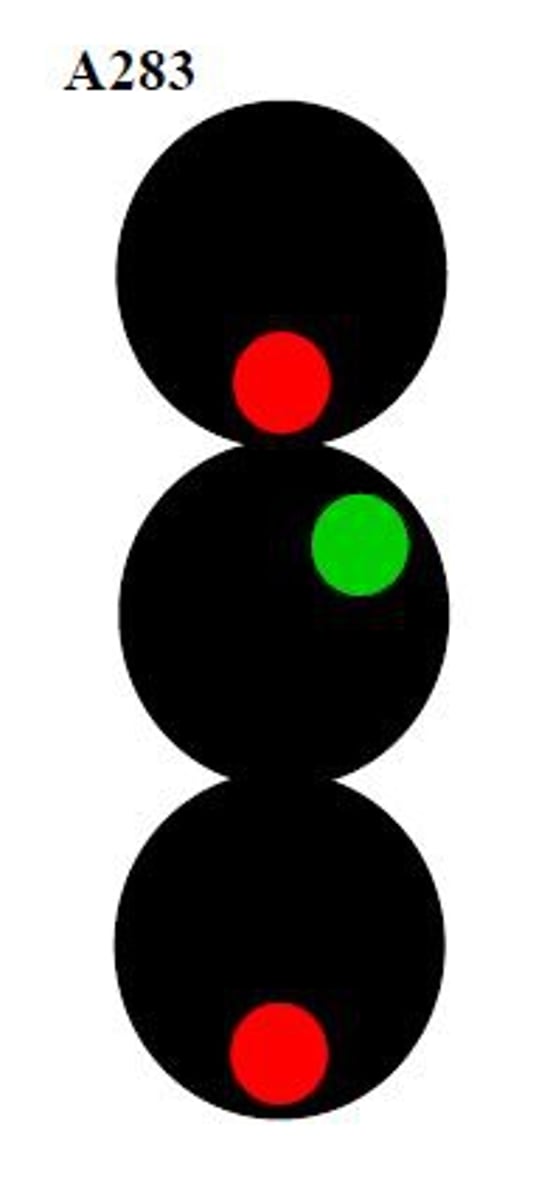LIRR Signals & Definitions
1/210
There's no tags or description
Looks like no tags are added yet.
Name | Mastery | Learn | Test | Matching | Spaced |
|---|
No study sessions yet.
211 Terms
A length of track of defined limits, the use of which is governed by block signals, block-limit signals, automatic speed control or any combination thereof.
BLOCK
A block established between block stations, block limit stations, interlockings or any combination thereof which must not be occupied by more than one train except as provided by the rules.
ABSOLUTE BLOCK
A block signal system wherein the use of each block is governed by an automatic block signal, the cab signal indicator or both.
AUTOMATIC BLOCK SIGNAL SYSTEM
A series of consecutive blocks.
BLOCK SIGNAL SYSTEM
A block signal system wherein the use of each block is governed by block signals controlled manually, by block-limit signals or both, upon information received by telephone, radio or other means of communication.
MANUAL BLOCK SIGNAL SYSTEM
A system so arranged that its operation will automatically result in the following: A full service application of the train brakes if, while operating under a speed restriction, the speed of the train exceeds the predetermined rate. The application will continue until the train is either brought to a stop or, under the control of the engineer, its speed is reduced to the predetermined rate.
AUTOMATIC SPEED CONTROL SYSTEM (ASC)
A train equipped with the following speed control apparatus, a cab signal indicator, sealed application valve or switch, audible warning device and acknowledging switch, in operative condition for the direction in which it is to move.
SPEED CONTROLLED TRAIN
A unit propelled by any form of energy or a combination of units operated from a single control, used in road or yard service.
ENGINE (ENG)
Equipment capable of being propelled by electrical energy through the use of third rail contact shoes.
MULTIPLE UNIT EQUIPMENT
A roadway maintenance machine, not classified as an engine, which is operated on track for inspection or maintenance. It may not shunt track circuits or operate signals and will be governed by rules and special instructions for trains other than passenger trains.
TRACK CAR (TC)
An arrangement of signals and signal appliances so interconnected that their movements must succeed each other in proper sequence and for which interlocking rules are in effect.
INTERLOCKING (INT)
The tracks between the extreme opposing home signals of an interlocking.
INTERLOCKING LIMITS
An employee assigned to a train or track car when the engineer, conductor or track car driver is not qualified on the physical characteristics or rules of the railroad or portion of the railroad over which the movement is to be made.
PILOT
The appearance of a fixed signal which conveys an indication as viewed from the direction of an approaching train; the appearance of a cab signal indicator as viewed in the engine control compartment.
ASPECT
A fixed signal indicating the limit of the block, the use of which is governed by manual block signal system rules.
BLOCK-LIMIT SIGNAL
A fixed signal or a hand signal in the absence of a fixed signal, at the entrance to a block that governs trains using that block.
BLOCK SIGNAL
A signal indicator located in the engine control compartment displaying the maximum speed for the movement of the train. It will be used in conjunction with interlocking signals and either in conjunction with or in lieu of block signals.
CAB SIGNAL INDICATOR
A fixed signal used to govern the approach to a home signal.
DISTANT SIGNAL
A signal of a fixed location indicating a condition which affects the movement of a train.
FIXED SIGNAL
A fixed signal that displays Stop signal as its most restrictive aspect and governs the entrance to a route or block.
HOME SIGNAL
The information conveyed by the aspect of a signal.
INDICATION
The fixed signals of an interlocking.
INTERLOCKING SIGNALS
A highly visible marking device in the red-orange-amber color range, affixed to the rear of the train to indicate that the train is complete.
MARKER
A transponder and data-radio based train-control system which will automatically apply the brakes of an equipped train if, while approaching a Speed Restriction or Positive Train Stop Location, the speed of the train exceeds the predetermined rate.
ADVANCED CIVIL SPEED ENFORCEMENT SYSTEM (ACSES)
A Passenger or Freight class train equipped with the following ACSES controlled apparatus: A Data Radio, Aspect Display Unit, sealed ACSES valve or switch, audible warning device and acknowledging switch in operative condition.
ACSES CONTROLLED TRAIN
A method of establishing working limits on a main track, secondary track or siding in which a roadway worker is notified by the Train Dispatcher through the Block Operator that no trains will operate within the working limits established on that track until the roadway worker reports clear of the track.
FOUL TIME
A method of establishing working limits on tracks not controlled by the Train Dispatcher or Block Operator by physically preventing the entry and movement of trains.
INACCESSIBLE TRACK
When reporting for duty, employees whose duties require coordination with other employees must hold a job briefing to review operational and safety conditions. If these conditions change, employees must hold an additional job briefing to discuss the new conditions.
JOB BRIEFING
An employee of a railroad, or of a contractor to a railroad, whose duties include inspection, construction, maintenance or repair of railroad track, bridges, roadway, signal and communication systems, electric traction systems, roadway facilities or roadway maintenance machinery on or near track or with the potential of fouling a track and flagmen and watchmen/lookouts responsible for their protection.
ROADWAY WORKER
A properly equipped employee that has been annually trained on roadway worker protection whose sole duty is to provide at least 15 seconds advanced visual and auditory warning of approaching trains or on-track equipment to roadway workers.
WATCHMAN/LOOKOUT
A segment of track with definite boundaries upon which trains may move only as authorized by the roadway worker in charge of that segment of track.
WORKING LIMITS
A speed not exceeding 45 mph.
LIMITED SPEED
The highest speed that is permitted over a specific portion of the railroad. It may be authorized by the special instructions of the current timetable, Rules of the Operating Department or any other publication authorized by the General Superintendent-Transportation
MAXIMUM AUTHORIZED SPEED (MAS)
A speed not exceeding 30 mph, except in ASC territory, train will be governed by speed displayed on the cab signal indicator not to exceed 40 mph.
MEDIUM SPEED
A speed at which a train can be stopped short of another train or obstruction.
REDUCED SPEED
A mode of operation, at which a train can be stopped within one half the range of vision, short of the next signal, another train, obstruction, derail, or switch improperly lined, looking out for broken rail or crossing protection not functioning, not exceeding 15 miles per hour.
RESTRICTED SPEED (RS)
A speed not exceeding 15 mph, except in ASC territory, train will be governed by speed displayed on the cab signal indicator not to exceed 30 mph.
SLOW SPEED
A switch identified by a yellow switch stand. Trains may make trailing point moves through the switch without previously aligning it by hand unless otherwise specified.
AUTOMATIC SAFETY SWITCH
A track connection between two adjacent, not necessarily parallel tracks, consisting of a minimum of two switches, which is intended to be used primarily for the purpose of crossing over from one track to another.
CROSSOVER
A track safety device, fixed or portable, designed to guide a car off the rails at a selected location on a track as a means of protection against collisions or other accidents.
DERAIL
A power-operated switch also equipped for hand operation.
DUAL CONTROL SWITCH
A hand-operated switch equipped with an electrical device that restricts the movement of the switch.
ELECTRIC LOCK SWITCH
A switch that must be aligned by hand before a train makes a trailing point movement through the switch.
HAND-OPERATED SWITCH
A switch within interlocking limits controlled by the Block Operator or Train Dispatcher working in conjunction with interlocking signals and other interlocking appliances.
INTERLOCKING SWITCH
A switch equipped with a spring mechanism that will restore the switch points to the normal position after having been trailed through.
SPRING SWITCH
A place at which a block-limit signal is displayed.
BLOCK-LIMIT STATION
A place at which manual block signals are displayed.
BLOCK STATION
A place from which an interlocking is operated.
INTERLOCKING STATION
A place at which trains are scheduled to receive and/or discharge passengers.
PASSENGER STATION
A place designated by name on the station pages of the current timetable.
STATION
A notice issued to employees by the General Superintendent-Transportation. It may contain special schedules or other information pertaining to track work programs or special events and will be issued at a minimum of once per week.
BULLETIN NOTICE (BN)
A notice issued to employees by the General Superintendent-Transportation. It may contain operating instructions or other information as may be necessary.
GENERAL NOTICE (GN)
An order issued to employees by the General Superintendent-Transportation. It may change or annul operating rules, timetable information or special instructions.
GENERAL ORDER
That part of a timetable that prescribes direction, number, and movement of a regular train.
SCHEDULE
A daily bulletin containing necessary speed restrictions issued by the Train Dispatcher.
TEMPORARY SPEED RESTRICTION BULLETIN (TSRB)
The authority for the movement of regular trains subject to the rules. It contains classified schedules and special instructions relating to the movement of trains.
TIMETABLE
A designated track, the entrance and exit of which are governed by home signals.
CONTROLLED SIDING
The movement of trains on a main track in one direction, as specified by special instruction.
CURRENT OF TRAFFIC
A track, or series of tracks, serving the needs of a commercial industry other than a railroad.
INDUSTRY TRACK
A designated track upon which trains are operated by timetable, Form L or both or the use of which is governed by block signals.
MAIN TRACK
A designated track upon which trains may be operated without timetable or Form L authority, or block signals subject to the prescribed signals, rules and special instructions.
SECONDARY TRACK
A designated track adjacent to a main track for the meeting or passing of trains.
SIDING
A main track upon which trains are operated in both directions.
SINGLE TRACK
Two or more main tracks upon which trains are operated as designated in the special instructions.
TWO OR MORE TRACKS
A system of tracks, other than main tracks, secondary tracks or sidings, used for making up trains, storing cars and other purposes. All movements are subject to prescribed signals, rules and special instructions.
YARD
A portion of single main track between yard limit boards, as specified by special instruction.
YARD LIMITS
Any on-track vehicle, except a wreck train, that is used to house railroad or contract employees.
CAMP CAR
A train not authorized by a timetable schedule. It must be designated as:
Passenger Extra - for passenger train extra.
Work Extra - for work train extra.
Track Car Extra - for track car extra.
Extra - For any other extra train except passenger extra, work extra or track car extra.
EXTRA TRAIN
A train carrying revenue passengers.
PASSENGER TRAIN
A train consisting of a bi-level cab control car at one end and a diesel or dual mode locomotive at the opposite end.
PUSH-PULL TRAIN
A train authorized by a timetable schedule.
REGULAR TRAIN
A train having precedence over another train.
SUPERIOR TRAIN
An engine or more than one engine coupled, with or without cars, displaying markers.
TRAIN
A train given precedence in the direction specified as between opposing regular trains.
TRAIN OF SUPERIOR DIRECTION
A train given precedence by Form L.
TRAIN OF SUPERIOR RIGHT
NAME: Clear-Block.
INDICATION: Proceed; manual block clear.
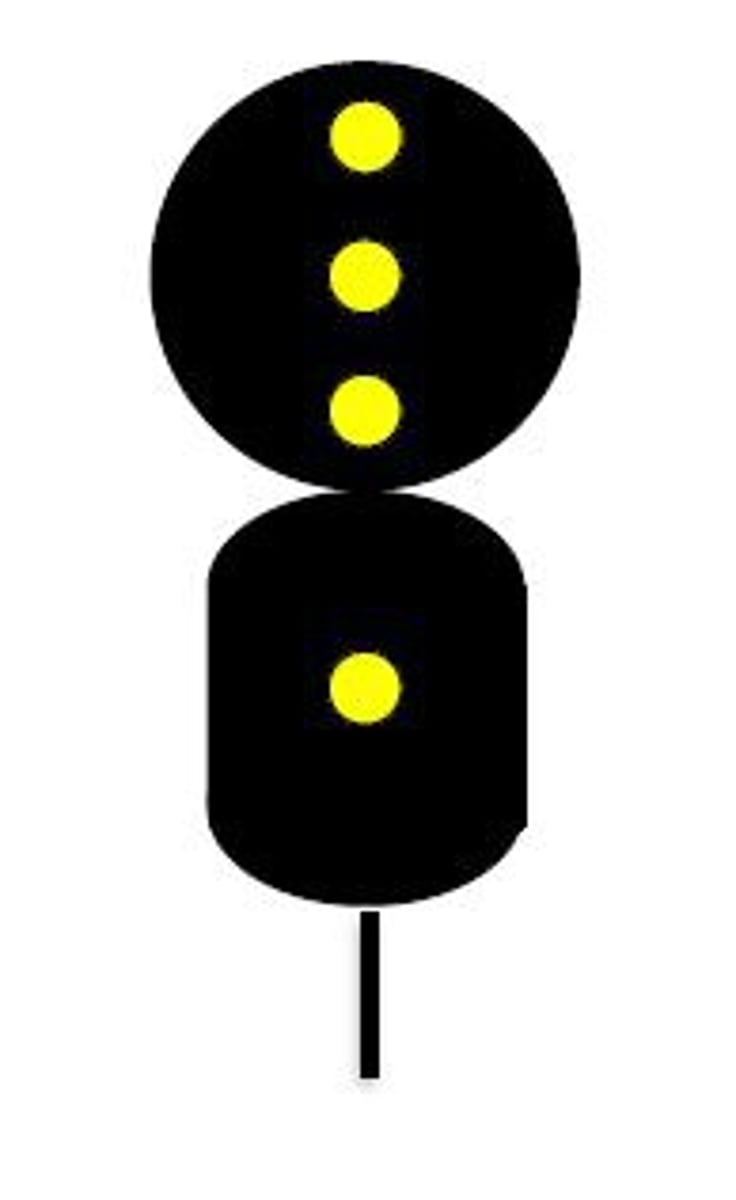
NAME: Clear-Block.
INDICATION: Proceed; manual block clear.
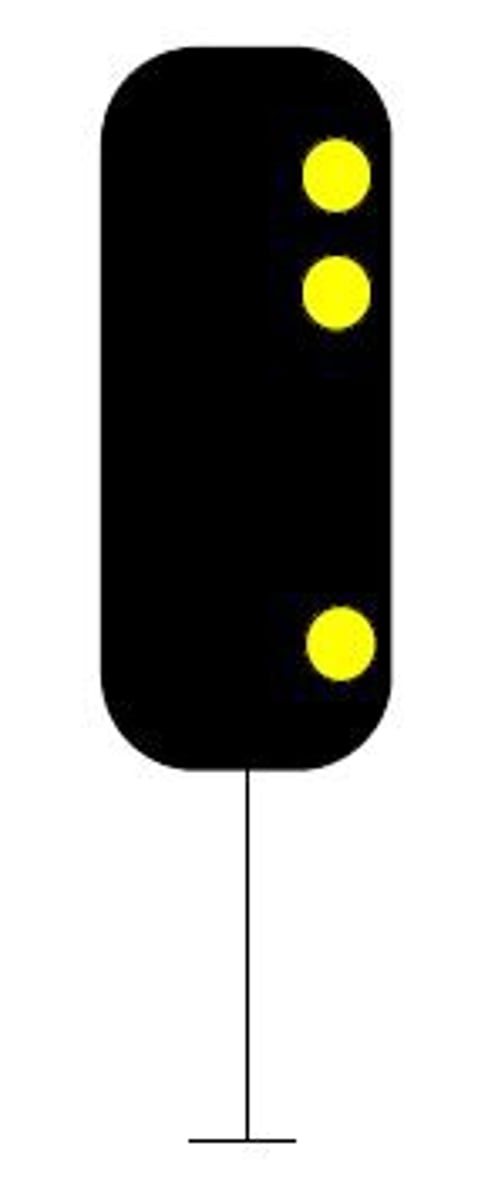
NAME: Clear-Block.
INDICATION: Proceed; manual block clear.

NAME: Clear-block.
INDICATION: Proceed; manual block clear

NAME: Stop-signal.
INDICATION: Stop.
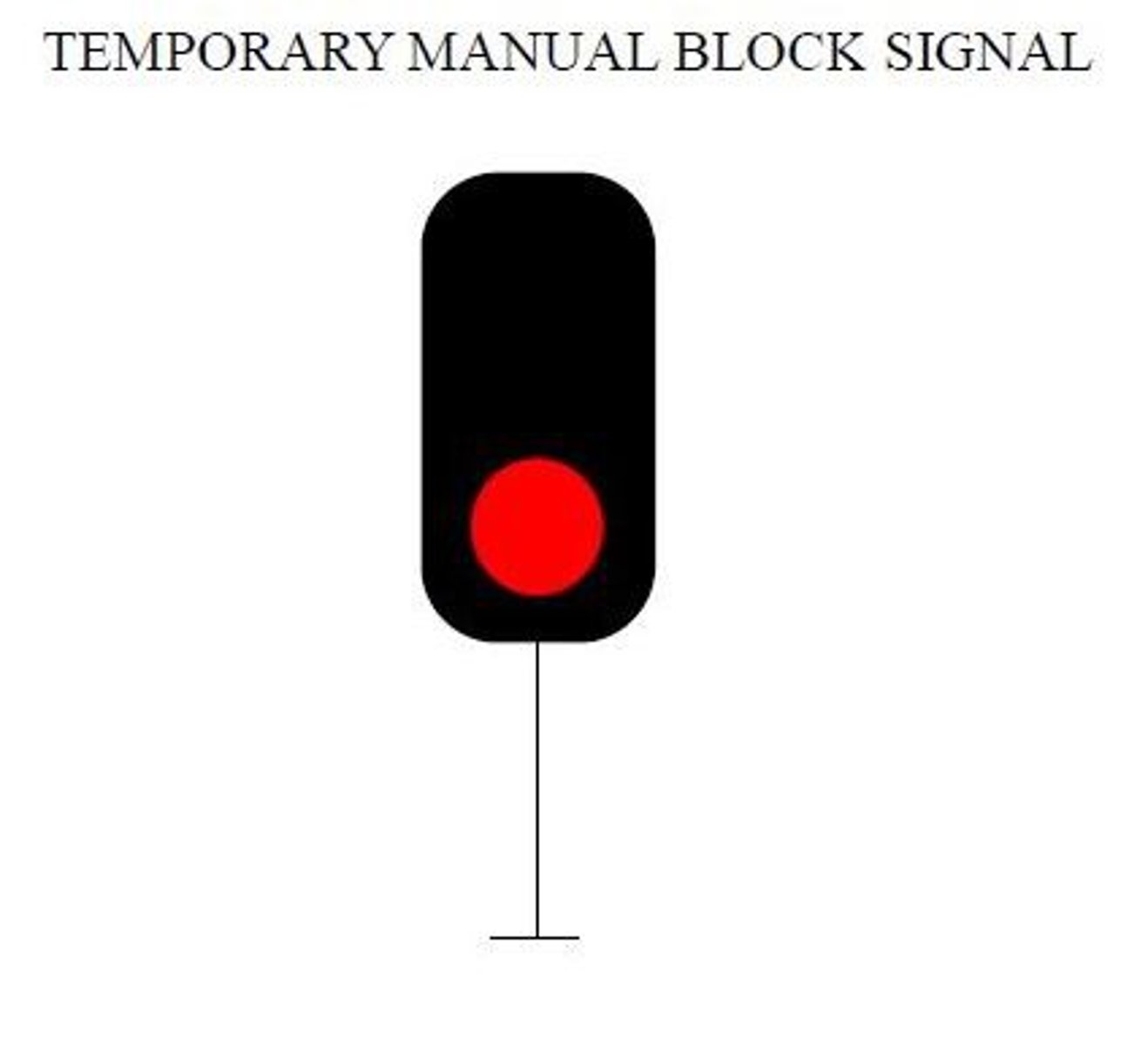
NAME: Clear.
INDICATION: Proceed.

NAME: Clear.
INDICATION: Proceed.

NAME: Clear.
INDICATION: Proceed.
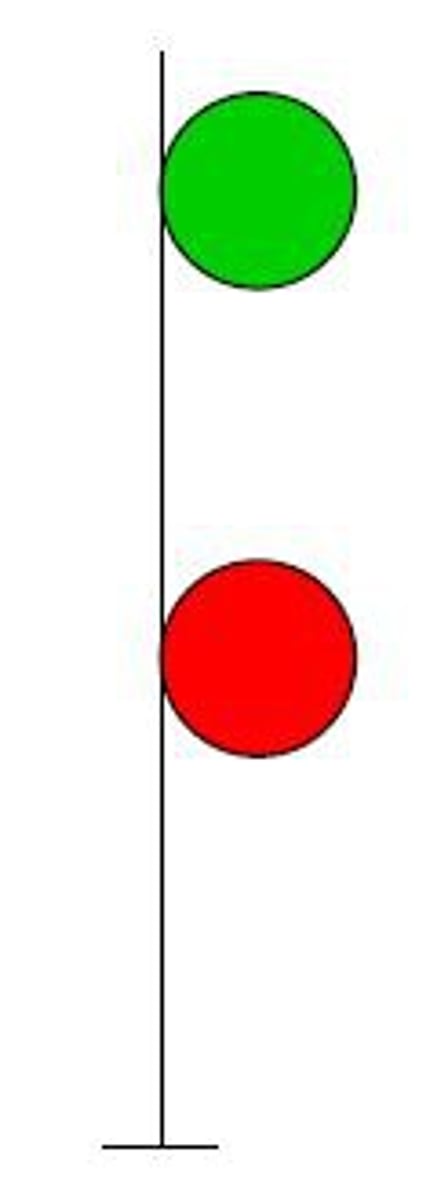
NAME: Clear.
INDICATION: Proceed.
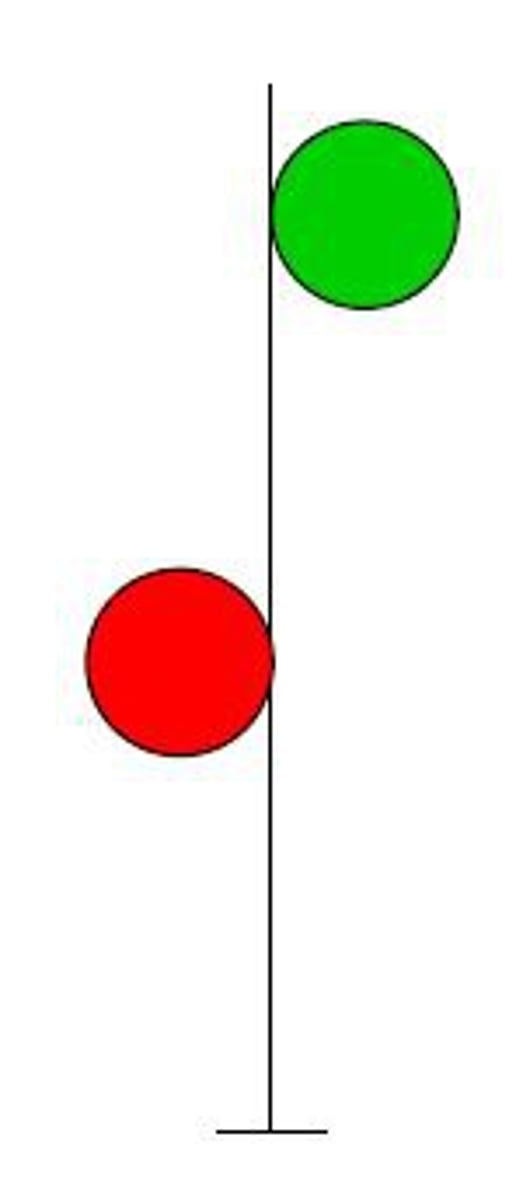
NAME: Clear.
INDICATION: Proceed.

NAME: Clear.
INDICATION: Proceed.

NAME: Absolute-Clear.
INDICATION: Proceed; Track clear to next interlocking signal. Approach next interlocking signal prepared to stop.

NAME: Absolute-Clear.
INDICATION: Proceed; Track clear to next interlocking signal. Approach next interlocking signal prepared to stop.
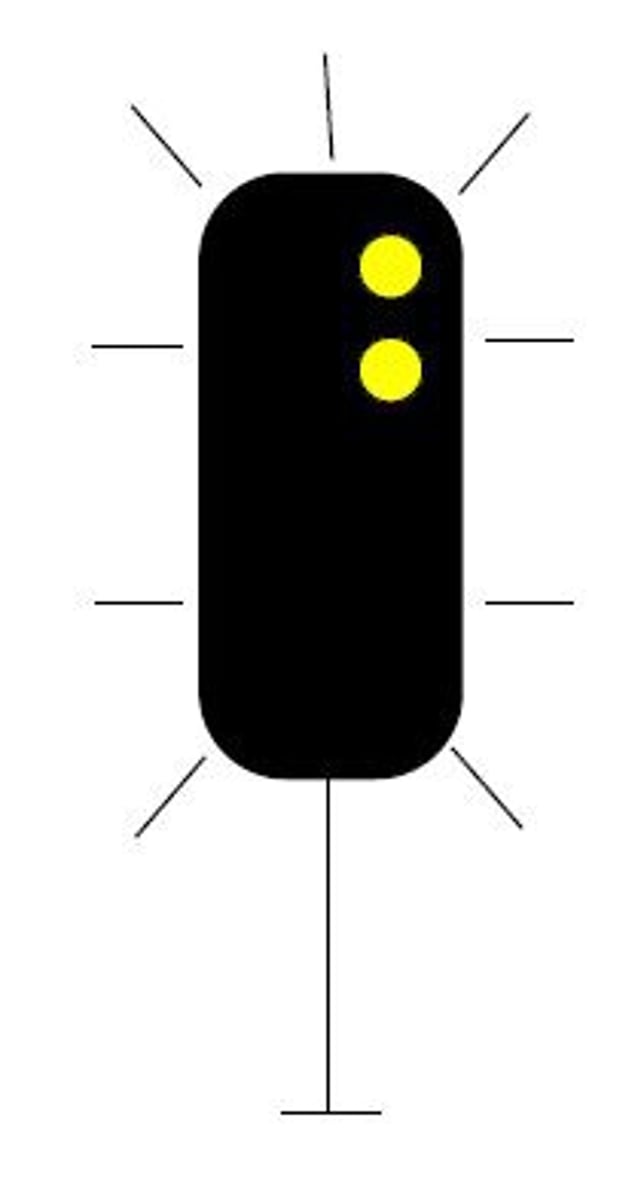
NAME: Absolute-Clear.
INDICATION: Proceed; Track clear to next interlocking signal. Approach next interlocking signal prepared to stop.
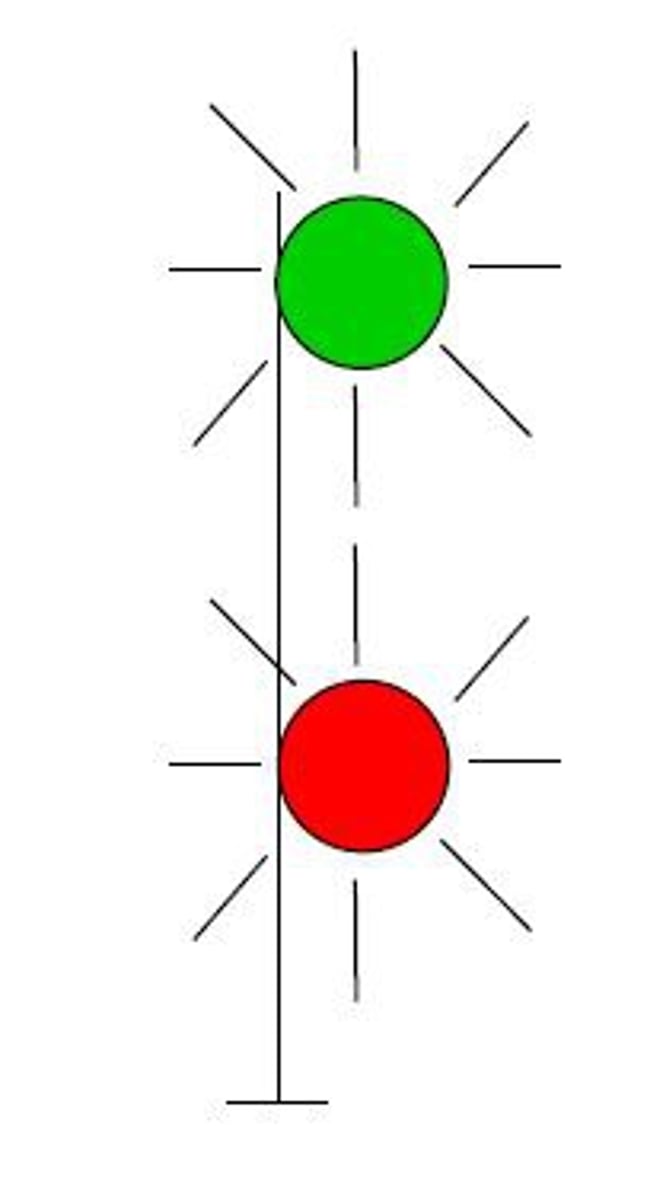
NAME: Absolute-Clear.
INDICATION: Proceed; Track clear to next interlocking signal. Approach next interlocking signal prepared to stop.

NAME: Approach-medium.
INDICATION: Proceed approaching next signal at Medium speed.
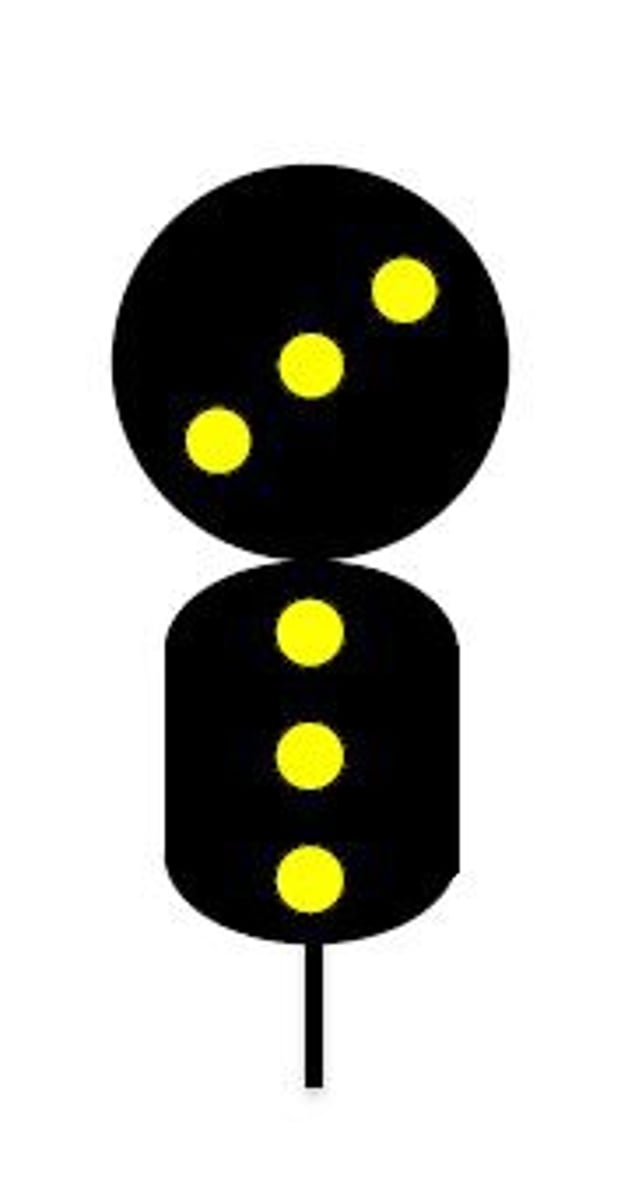
NAME: Approach-medium.
INDICATION: Proceed approaching next signal at Medium speed.
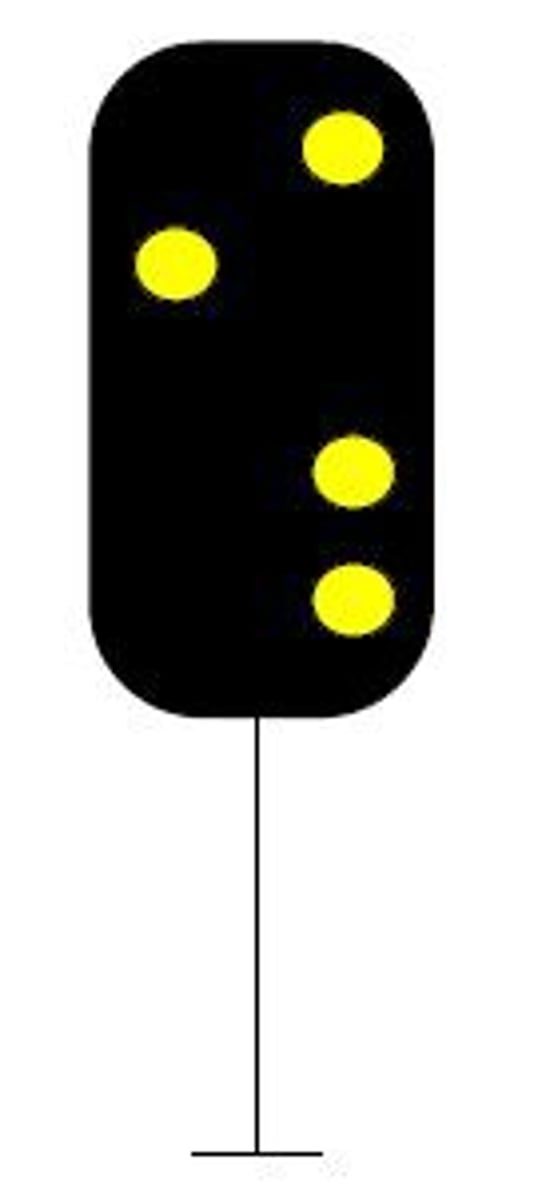
NAME: Approach-medium.
INDICATION: Proceed approaching next signal at Medium speed.

NAME: Approach-medium.
INDICATION: Proceed approaching next signal at Medium speed.

NAME: Approach-medium.
INDICATION: Proceed approaching next signal at Medium speed.
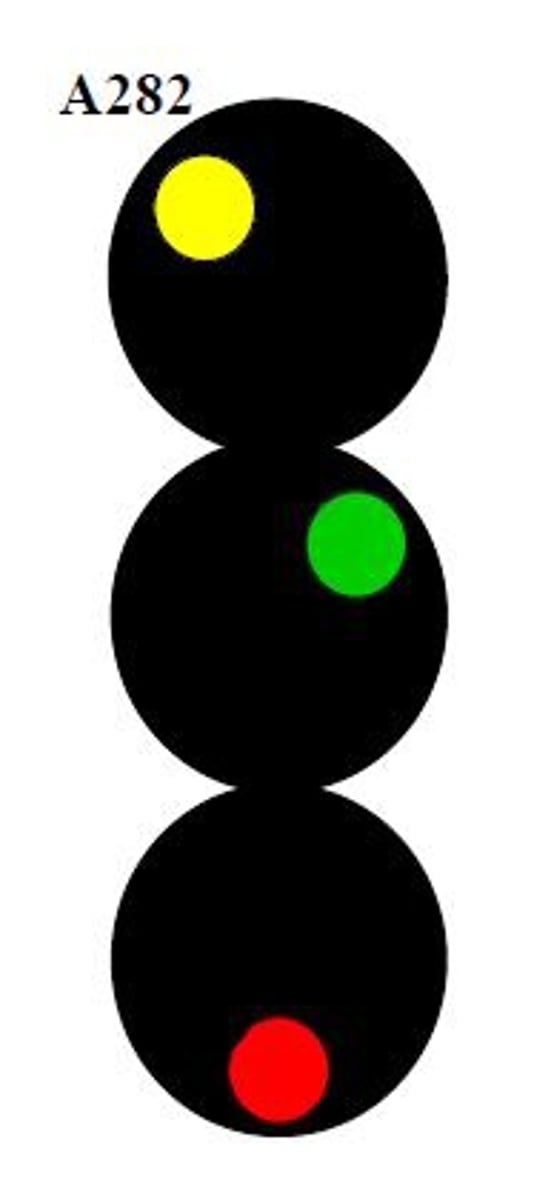
NAME: Medium-clear.
INDICATION: Proceed; Medium speed within interlocking limits.
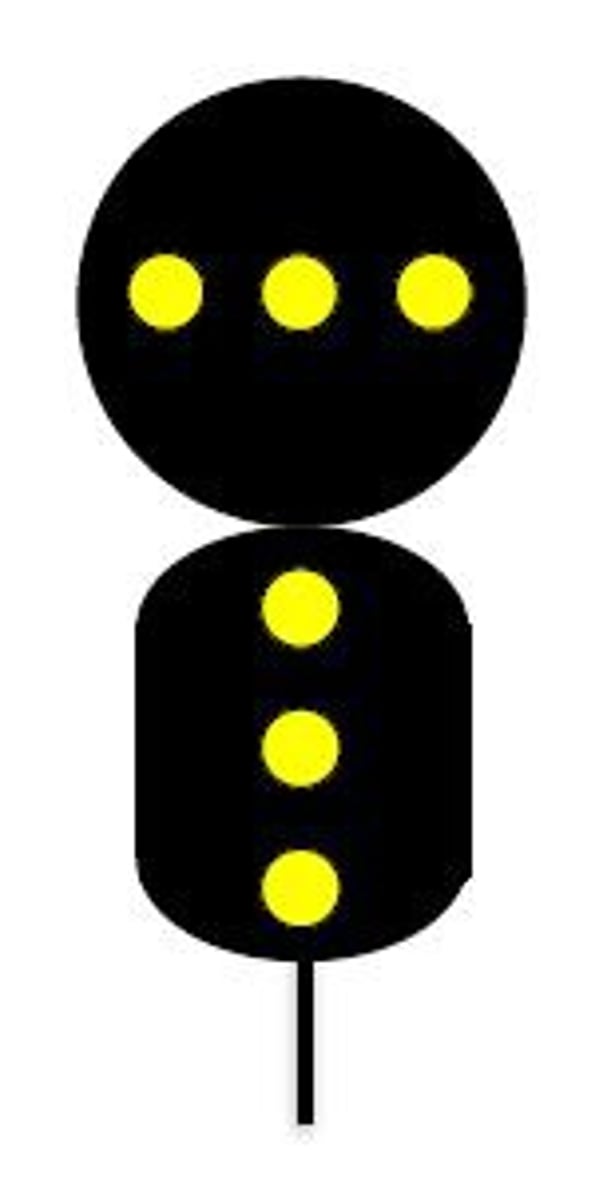
NAME: Medium-clear.
INDICATION: Proceed; Medium speed within interlocking limits.

NAME: Medium-clear.
INDICATION: Proceed; Medium speed within interlocking limits.

NAME: Medium-clear.
INDICATION: Proceed; Medium speed within interlocking limits.

NAME: Medium-clear.
INDICATION: Proceed; Medium speed within interlocking limits.
